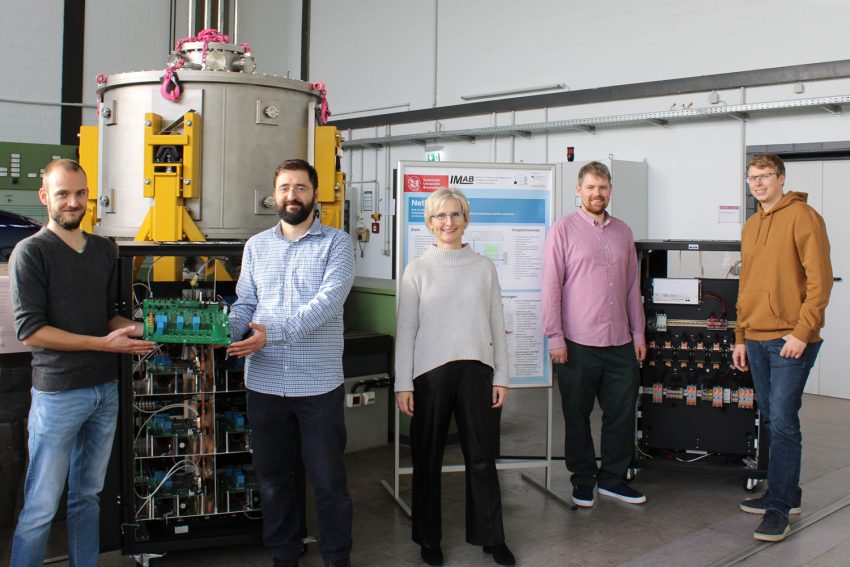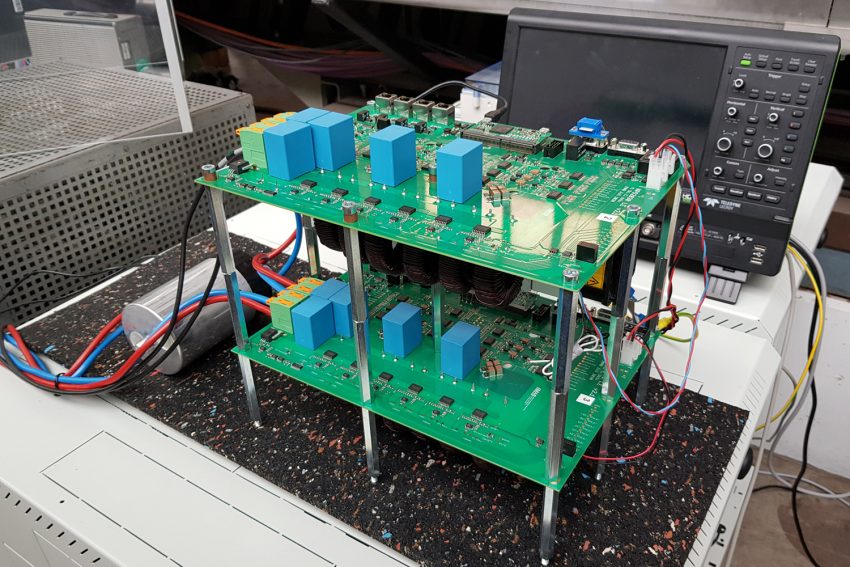Compact, highly efficient and durable TU Braunschweig researches the reliability and service life of power electronics
The boom in electric vehicles, photovoltaic systems and heat pumps is placing new demands on power electronics. This is precisely where the joint project NetFlexum comes in. The Institute for Electrical Machines, Traction and Drives (IMAB) at Technische Universität Braunschweig, together with another TU institute and external partners, is researching solutions in the field of power electronics to further increase the reliability, safety and service life of the components and their assembly and connection technology.

The power electronics research team at IMAB includes (from left) research assistants Tobias Fricke and Cengiz Uzlu, Professor Dr.-Ing. Regine Mallwitz and research assistants Philipp Hauenschild and Matthias Klintz. Photo credit: IMAB/TU Braunschweig
With highly efficient and compact power electronic converters, renewable energy sources such as photovoltaics or wind power can be used in the first place. Small, lightweight converters are indispensable when it comes to board supply and the drive of electric vehicles. “Power electronic converters are subject to very different requirements,” says Regine Mallwitz, Professor of Power Electronics at IMAB.
The scientists at the institute are therefore not only investigating the most suitable circuits, called topologies, and their control options. The focus is also on the correct calculation and dimensioning of the components and the selection of a suitable assembly and connection technology. Functionality, high efficiency, small construction volume and low weight – these are the requirements that power electronics must fulfil depending on the application. In the joint project NetFlexum, reliability, safety and service life are now also being specifically researched.
Grid-serving prosumer systems
In particular, the research interest is directed towards a reliable instantaneous reserve provision by using novel control strategies grid-serving prosumer systems. The word prosumer combines the words “producer” and “consumer”.
For example, consumers can simultaneously purchase electricity and also produce it via the photovoltaic system on their own roof and feed it into the grid. Advanced grid-serving home storage systems, for example, are about better integrating the electricity generated by a photovoltaic system into the power grid. In the NetFlexum project, this is the research focus of the elenia Institute for High Voltage Technology and Power Systems at TU Braunschweig, headed by Professor Bernd Engel.
Power peaks and service life

Basic modules of multifunctional power electronics undergo electrical tests in IMAB’s laboratory. Photo credit: IMAB/TU Braunschweig
IMAB’s research team is investigating innovative operating applications of individual power electronic circuits with a view to their reliability and service life for new topologies. In the case of power electronics, the focus is on insulating, non-galvanically isolating systems. “In the case of instantaneous reserve call-up, the power electronics must be able to be overloaded for a short time,” says Professor Mallwitz. “It must therefore be proven for the power semiconductors that short-term power peaks do not negatively influence the service life.”
Such power peaks are also a potential burden for the already aged 2nd-life storage systems – this is the further use of discarded vehicle batteries in stationary electricity storage systems. The research team at the Physikalisch-Technische Bundesanstalt, a partner in the joint project NetFlexum, will carry out a residual life assessment for batteries.
Developing a direct current (DC) protection concept and testing it in a DC demonstration network with direct and indirect connection of the battery system are the tasks of a research team at elenia led by Professor Michael Kurrat. “Only when the entire system is considered, it is possible to optimise it economically without any loss of reliability or safety,” says Professor Mallwitz.
Simulation of ageing processes
When it comes to service life, wear plays an important role. Rapid ageing tests for the hardware are therefore also part of the research project. IMAB not only has a workshop equipped with high-tech manufacturing facilities, but also state-of-the-art test benches for measuring power electronics and electrical machines, as well as extensive laboratory and experimental facilities.
A new addition to the IMAB’s newly renovated laboratory is a compact climate chamber in which circuits can be exposed to extreme cold, heat and humidity. The climate tests serve the scientists to simulate ageing processes, but also to prove that a component is functional in a certain climate.
Project data
The joint project NetFlexum will run for three years (September 2022 to August 2025). It is funded by the Federal Ministry for Economic Affairs and Climate Protection with a total of more than 2.5 million euros and supervised by Project Management Jülich. Project partners are TU Braunschweig, the Physikalisch-Technische Bundesanstalt and two industrial partners, SMA Solar Technology AG and TEMES Engineering GmbH.
Power electronics at IMAB
In addition to developing suitable converters for innovative electrical machines, IMAB scientists are researching topics such as inductive energy transmission, the development of charging technology for electric vehicles and for stationary storage, high-performance DC-DC converters and grid inverters for photovoltaic systems. In order to make these systems as compact and energy-efficient as possible, IMAB is investigating the use of the wide-band-gap semiconductor materials silicon carbide and gallium nitride, which can be used to reduce losses and increase switching frequencies. The influence of the increase in switching frequency on the volume and weight of the passive components is another focus. In the process, emphasis is always placed on the construction of prototypes.
